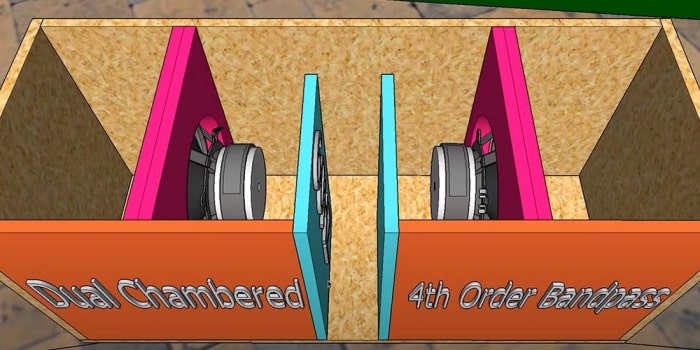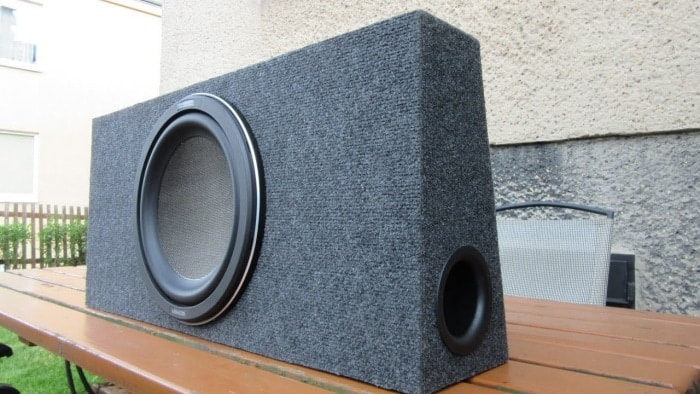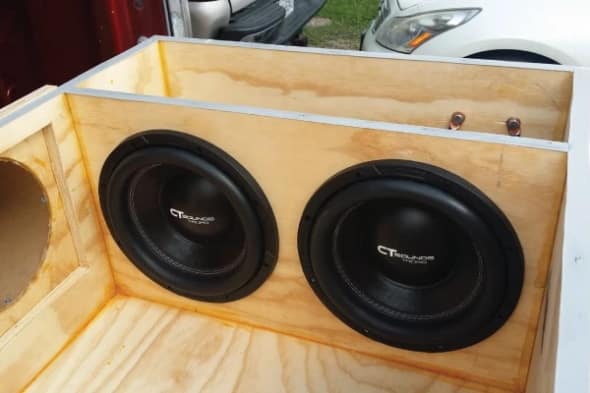While tweeters and mid-range speakers are responsible for highs and mids, a subwoofer reproduces low-pitched frequencies, highlighting the bass and sub-bass.
If you’re planning to buy a subwoofer, you also need to find a suitable enclosure for it. There are three main types of subwoofer enclosures, namely sealed, ported, and bandpass. And bandpass boxes are many customers’ go-to choices.
What is a bandpass box? A bandpass box is an enclosure housing the subwoofer speaker entirely. It helps the subwoofer highlight the right bass quality by producing louder bass with lots of slam at certain frequencies.
This article will look at different types of bandpass boxes and the major pros and cons. Let’s read on to understand more about this kind of enclosure.
What Is A Bandpass Box?
A bandpass box bears a unique design with two chambers. The chamber housing the subwoofer is a sealed box, and in the front, the latter is a ported box. Simply put, it’s like a combination of a ported and a sealed enclosure.
The ported box is where the sound comes from, and the volume here is super loud. That’s the reason bandpass enclosures are best at highlighting the low bass for hip-hop, reggae, hard rock, and metal.
A difference between bandpass vs ported is the position of the rear and the port. In a bandpass, these two parts are in two separate enclosures, whereas with a ported box, the rear and the port of the driver are in the same enclosure.
Different Types Of Bandpass Box

When setting out to get a bandpass enclosure, you can choose between double reflex bandpasses and single reflex bandpasses.
How these two bandpass box types differ is exactly similar to how a ported box differs from a sealed box.
In the single-reflex design, you’ll find the sealed chamber at the rear end and the ported chamber, where the sound comes from, at the front.
Besides, the dual-reflex design connects the listening area to both rear and front chambers with a port.
A single reflex box’s frequency range is about 12 dB/octave, which features a pretty good transient response. If you want a small box that delivers high sound quality, the single reflex type is the way to go.
Meanwhile, you can experience a sharper music quality with a dual reflex, whose frequency ranges from 18 to 24 dB/octave.
This type of bandpass box is more efficient than the first one, controlling motion cones over a broader range.
Due to the higher frequency roll-off rate, a double reflex usually has a larger size, generating the same frequency extension as the single reflex box.
All in all, if you’re seeking a decent-sized bandpass box emitting good-quality sound with nice transient features and adequate frequencies, a single reflex is right for you.
A double reflex requires more trunk space and often delivers a slower transient response, so you may find it a little impractical for you.
However, if your car has a large space and you want a more pounding and manifest quality of music, it’s a perfect choice with a dual flex bandpass box.
Why Is Bandpass Enclosure So Powerful?
As the name suggests, a bandpass enclosure allows only a certain bass output band or array to pass through the enclosure and enter the listening environment. So it should be clear to you how a bandpass box works now.
In a bandpass enclosure, the sounds go directly into the ported box at the front, where they’re filtered to eliminate high frequencies. The box only releases the band of bass that features a low frequency.
That’s the reason you can enjoy deep bass notes in narrow frequencies using a bandpass subwoofer box. You won’t find such a deep bass output in any other type of enclosure.
What Are Pros Of Bandpass Subwoofer?

Due to the unique design, bandpass enclosures are extremely good at generating high-quality music.
Nevertheless, like any other subwoofer boxes, this type also comes with noteworthy disadvantages that may make you think twice about buying one.
High Efficiency
As discussed, the speaker’s high frequencies have less chance to reach listeners thanks to the low-pass filter system.
Some may say this point is not really advantageous, provided that they can achieve low-frequency response by putting a low-pass crossover on the speaker.
This way, although you can minimize some high frequencies, a bandpass enclosure offers much better efficiency.
Plus, its bass extension is a significant step ahead of traditional subwoofer enclosure designs. Are you fond of exciting performances without a tremendously large space? You know which is the best choice.
Low Excursion
A bandpass box exerts great control over motion cones so that it can shorten the travel time of the cone within a decent distance from its original place. In a word, the enclosure comes with a low excursion.
Users would usually expect low-frequency drivers to have a pretty high excursion because they have to move tons of air. So it’s a huge advantage that makes bandpass subwoofer enclosures appeal to many strict bassheads.
Thanks to the lower excursion, a bandpass box can avoid forcing the driver to go beyond its mechanical limits - the major reason for a shorter speaker lifetime.
Durable
The box provides you with nice control of music quality. You can adjust the cone at will to make sure it moves properly per the frequency bandwidth that the speaker delivers.
Therefore, the box can generate the best sound quality without any damage because of unnecessary wear and tear. In a word, a bandpass enclosure will guarantee the sunwoofer’s durability.
A variety of sizes
When it comes to subwoofers for cars, size speaks volumes. If you set up some 8-niche drivers in an enclosure; needless to say, it’ll be a terrible experience.
Although it may occupy extra space, a big subwoofer box is still the best. They are extremely good at reproducing low frequencies. Thus, you can enjoy a smoother and deeper frequency response with a large enclosure.
Plus, sizable boxes benefit the traveling of low frequencies as they contain a larger amount of air. Their efficiently large magnet and cone contribute greatly to this driving process.
What's About Cons?

Motion Resistance
Despite the effective cone motion controlling, this technology also results in some significant problems.
The speaker generates a high level of acoustic output without pushing to the cone’s speed, hence deterring the cone from encountering excursion limits.
But you don’t have to worry much about this issue. The subwoofer’s motor will try hard to boost the speed of the cone instead.
The noteworthy issue to take into account is that the constant conflict between the motor structure and the bandpass box’s air pressure will pose motion resistance.
This force mainly aims at the glue point and your speaker’s suspensions. If you adopt excess power, it can ruin the drivers immediately.
Thus, users have to know the ways to handle the power supply properly so that they can extend their subwoofer’s lifespan.
Hard To Construct
We have to say that those who designed and manufactured bandpass boxes must be highly skilled constructors.
When building a bandpass’s construction, you mustn’t make a mistake. A minor error, like a volume miscalculation, can hurt your investment.
Plus, you have to find the ports that are compatible with the box in size. Or else, you’ll struggle to integrate these vents.
Once you fail to follow the producer’s instructions, you’ll damage the woofer or make it fail to work. Hence, if you’re a beginner, you’d better use a pro’s help to design the bandpass enclosure.
Masking Distortion
The subwoofer is entirely inside the sealed chamber, so the box will mask distortions. Most of you never realize that distortions might severely damage the subwoofer.
Despite excellent durability, the box’s lifespan will also dramatically reduce if you don’t have adequate skills to control cone motion and identify the vague signs of distortions.
Bandpass Box Vs Ported Box
When it comes to a bandpass box vs ported box, users often find it hard to weigh up which is the better subwoofer enclosure.
A misbelief is that ported boxes apply to movies or home theaters rather than music. There’s a crowd of those who prefer a ported sub in their cars as it offers more volume.
Like bandpass boxes, ported ones are perfect for heavy music, like hip-hop, rock, or metal. Its port amazingly highlights the bass quality and provides enough sound for a very large limousine.
However, the music coming out of the port sometimes is too loud for a narrow range of frequencies.
Meanwhile, bandpass enclosures are exceedingly efficient within this range. They are more likely to boom and satisfy customers’ desire for rap, hard rock, and reggae.
Conclusion
What is a bandpass box? You already know the answer to this common question and, more importantly, have another subwoofer enclosure option when setting up your car’s audio.
If you’re planning to upgrade the sound system of your car, a new, pounding subwoofer would be an interesting idea. Its aggressive sound will add excitement to your rock n’ roll parties on cars.
Before buying a bandpass box, you should weigh up its pros and cons thoroughly to have the most informed shopping decision.
Thank you for reading!
